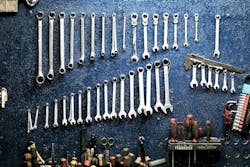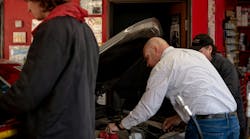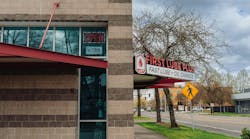Cadillac recently introduced a new prestige sedan, the 2016 CT6. Cadillac claims the CT6 takes drivers to a higher threshold of involvement, with technologies that make them more aware of their surroundings, chassis systems that make the most of control in all conditions and powertrains led by an all-new Cadillac Twin Turbo engine. Passengers receive the brand’s ultimate expression of comfort, luxury and connectivity.
The all-new Omega architecture features 13 high-pressure aluminum castings in the body structure, creating a lighter, stiffer structure that also enables “bank vault” levels of quietness. Engineers conducted 50 million hours of computational analysis — including 200,000 structural simulations — in its development, generating 21 patents.
The all-new Cadillac 3.0L Twin Turbo engine offers an estimated 400 horsepower and 400 pound-feet of torque, making it among the most power-dense V6 engines in the segment, at 133 horsepower per liter. Efficiency is enhanced with the industry’s first application of cylinder deactivation technology on a turbocharged V6 engine, as well as an eight-speed automatic transmission.
The CT6 is also available with a 2.0L I4 turbocharged engine and a 3.6L V6 naturally aspirated engine, each with a new eight-speed automatic transmission.
Active-on-demand all-wheel drive featuring a continuously variable clutch that infinitely varies power delivery to the front wheels — up to 959 pound-feet — makes the most of handling and stability in all conditions. Its lightweight, compact design and two-gear transfer case enable greater fuel economy than conventional fixed-torque all-wheel drive systems. All-wheel drive is standard on all CT6 six-cylinder models.
The 2016 Cadillac CT6 is packed with technology. Auto vehicle hold technology is a driver-selectable feature that prevents forward/rearward vehicle creep when the driver’s foot is off the brake. It reduces fatigue during heavy stop-and-go traffic and improves vehicle control on steep grades. A true 360-degree camera view around the vehicle helps reduce blind spots, while a surround-view video recording system can record front and rear views while driving and provide 360 degrees of recording if the vehicle’s security system is activated. Enhanced night vision helps identify people, large animals and more via heat signatures on a display in the driver information center. The rear camera mirror is the industry’s first application of full-display technology, combining camera technology with the conventional inside mirror to project an unobstructed view in the mirror. Advanced park assist integrates automatic braking into automatic parking, and pedestrian collision mitigation technology provides pedestrian detection indications, alerts and automatic braking to avoid collisions. The vehicle also has wireless phone charging and OnStar 4G LTE with a Wi-Fi hotspot.
The technology doesn’t skimp on creature comforts either. The CT6’s extended comfort seats offer premium Opus leather, five massage programs, reclining rear seats and Cadillac’s first application of woven-in-seat heating elements. A quadzone climate system employs a secondary full-HVAC system that allows passengers to personalize temperature and airflow for each seating position, along with ionizing air purification. The Bose Panaray audio system features 34 strategically placed speakers for exceptional dynamic range and clarity, including the first automotive application of design and technology elements from Bose home entertainment and professional audio products.
The CT6 is available in three trims: Luxury, Premium Luxury and Platinum.
A 2016 CT6 rear-wheel-drive with a 2.0L turbo engine carries a starting MSRP of $54,490. A top-of-the-line 3.0L twin turbo engine with Platinum trim — which includes items such as the Driver Awareness and Convenience packages, front and rear automatic braking, Intellibeam headlamps and automatic safety belt tightening — carries a price tag of $88,460.
Servicing the CT6
Cadillac recommends Premium Care Maintenance for the CT6, with oil changes based on the vehicle’s oil life monitor system. When the “Change Engine Oil Soon” message displays, the engine oil and filter should be changed within the next 600 miles (1,000 km). If driven under the best conditions, the engine oil life system may not indicate the need for vehicle service for up to a year. The engine oil and filter must be changed at least once a year, and the oil life system must be reset.
Because of the way people use vehicles, maintenance needs vary. There may need to be more frequent checks and services. The additional required services – normal are for vehicles that carry passengers and cargo within recommended limits on the tire and loading information label, are driven on reasonable road surfaces within legal driving limits and use the recommended fuel. The additional required services – severe are for vehicles that are mainly driven in heavy city traffic in hot weather, are mainly driven in hilly or mountainous terrain, frequently tow a trailer, are used for high-speed or competitive driving or are used for taxi, police or delivery service.
ADDITIONAL REQUIRED SERVICES – NORMAL
Every 7,500 miles (12,000 km):
• Check engine oil level and oil life percentage; if needed, change engine oil and filter, and reset oil life system
• Check engine coolant level
• Check windshield washer fluid level
• Visually inspect windshield wiper blades for wear, cracking or contamination; replace worn or damaged wiper blades
• Check tire inflation pressures
• Inspect tire wear
• Visually check for fluid leaks
• Inspect engine air cleaner filter
• Inspect brake system
• Visually inspect steering, suspension and chassis components for damaged, loose or missing parts or signs of wear
• Check restraint system components
• Visually inspect fuel system for damage or leaks
• Visually inspect exhaust system and nearby heat shields for loose or damaged parts
• Lubricate body components
• Check starter switch
• Check automatic transmission shift lock control function
• Check parking brake and automatic transmission park mechanism
• Check accelerator pedal for damage, high effort or binding; replace, if needed
• Visually inspect gas strut for signs of wear, cracks or other damage; check the hold-open ability of the strut
• Inspect sunroof track and seal, if equipped
Every 22,500 miles (36,000 km) or every two years:
• Replace passenger compartment air filter; more frequent replacement may be needed if driving in areas with heavy traffic, poor air quality, high dust levels or environmental allergens; replacement may also be needed if there is reduced airflow, window fogging or odors
Every 45,000 miles (72,000 km):
• Inspect evaporative control system; visually check all fuel and vapor lines and hoses for proper attachment, connection, routing and condition
Every 45,000 miles (72,000 km) or every four years:
• Replace engine air cleaner filter
Every 60,000 miles (96,000 km):
• Replace spark plugs; inspect spark plug wires (in 2.0L and 3.0L turbo engines)
Every 97,500 miles (156,000 km):
• Replace spark plugs; inspect spark plug wires (in 3.6L engine only)
• Change transfer case fluid, if equipped with AWD
Every five years:
• Replace brake fluid
Every 150,000 miles (240,000 km) or every 10 years:
• Visually inspect all accessory drive belts for fraying, excessive cracking or damage; replace, if needed
ADDITIONAL REQUIRED SERVICES – SEVERE
Every 7,500 miles (12,000 km):
• Check engine oil level and oil life percentage; if needed, change engine oil and filter, and reset oil life system
• Check engine coolant level
• Check windshield washer fluid level
• Visually inspect windshield wiper blades for wear, cracking or contamination; replace worn or damaged wiper blades
• Check tire inflation pressures
• Inspect tire wear
• Visually check for fluid leaks
• Inspect engine air cleaner filter
• Inspect brake system
• Visually inspect steering, suspension and chassis components for damaged, loose or missing parts or signs of wear
• Check restraint system components
• Visually inspect fuel system for damage or leaks
• Visually inspect exhaust system and nearby heat shields for loose or damaged parts
• Lubricate body components
• Check starter switch
• Check automatic transmission shift lock control function
• Check parking brake and automatic transmission park mechanism
• Check accelerator pedal for damage, high effort or binding; replace, if needed
• Visually inspect gas strut for signs of wear, cracks or other damage; check the hold-open ability of the strut
• Inspect sunroof track and seal, if equipped
Every 22,500 miles (36,000 km) or every two years:
• Replace passenger compartment air filter; more frequent replacement may be needed if driving in areas with heavy traffic, poor air quality, high dust levels or environmental allergens; replacement may also be needed if there is reduced airflow, window fogging or odors
Every 45,000 miles (72,000 km):
• Inspect evaporative control system; visually check all fuel and vapor lines and hoses for proper attachment, connection, routing and condition
• Change automatic transmission fluid and filter
• Change transfer case fluid, if equipped with AWD
• Change rear axle fluid
• Change front axle fluid, if equipped with AWD
Every 45,000 miles (72,000 km) or every four years:
• Replace engine air cleaner filter
Every 60,000 miles (96,000 km):
• Replace spark plugs; inspect spark plug wires (in 2.0L and 3.0L turbo engines)
Every 97,500 miles (156,000 km):
• Replace spark plugs; inspect spark plug wires (in 3.6L engine only)
Every 150,000 miles (240,000 km) or every five years:
• Drain and fill engine cooling system
Every five years:
• Replace brake fluid
Every 150,000 miles (240,000 km) or every 10 years:
• Visually inspect all accessory drive belts for fraying, excessive cracking or damage; replace, if needed
Fluids & Capacities
Motor Oil: dexos1 5W-30, synthetic-blend recommended; capacity is 5.0 quarts (4.7 liters) – 2.0L I4 engine, 6.0 quarts (5.7 liters) – 3.0L V6 twin turbo, 6.5 quarts (6.15 liters) – 3.6L V6
Coolant: Dex-Cool; capacity is 9.1 quarts (8.6 liters) – 2.0L I4 engine, 10.9 quarts (10.3 liters) – 2.0L I4 engine with rear A/C, 11.2 quarts (10.6 liters) – 3.0L V6 twin turbo engine, 13.0 quarts (12.3 liters) – 3.0L V6 twin turbo engine with rear A/C, 13.9 quarts (13.2 liters) – 3.0L V6 twin turbo engine with rear A/C and auxiliary radiator, 10.4 quarts (9.8 liters) – 3.6L V6 engine, 12.0 quarts (11.4 liters) – 3.6L V6 engine with rear A/C, 3.4 quarts (3.2 liters) – 3.0L V6 twin turbo engine intercoolers
ATF: Dexron-HP S





